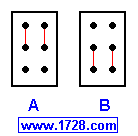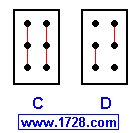|
|
Post by Mini-Strat_Maine on Oct 23, 2005 13:07:58 GMT -5
I had to edit this, partly because I now know how an ON-NONE-ON toggle differs from an ON-OFF-ON. (No center off! [We need a "light bulb' smilie.] ;D ) With the new Diagrams Sub-board getting underway, I thought I'd put in my request once more. I'm not all that good at reading schematics, but I think a wiring diagram would really help me with these changes to the original "Tone Monster" mod: - Push-pull (500K) volume pot for lead/rhythm selection. Will have a "treble bleed" kit on it.
- Lead tone pot push-pull, to select two different cap values. (Probably .015 and .047 µf.)
- Rhythm tone pot probably an RG500D. (See www.guitar-mod.com and click on "Passive Mods" in the list at the left of his home page. The pot is the first one described on the Mods page.)
I have the push/pull volume pot on-hand already. The miniature toggles (3PDT, ON-NONE-ON) I ordered from Mouser just arrived today, and they're the exact same size as the subminis that I got from Allied a few weeks ago. The only difference seems to be that the new batch is rated 1 amp higher at 125 and 250 VAC (6A/3A respectively) than the others. Does anyone have any thoughts on whether the selectable tone controls are a useful change, and/or about one or the other being better for lead or rhythm? I'm still not sure if I want to add any phase-change option(s) to it. Reading Unklmickey's reply to Zjokka in another thread makes me think that in/out of phase would involve only two pickups, or at least that would be the least "wobbly" to wire. Is that a good guess? If there's a large enough consensus that a phase switch would be worth the effort, I'd consider it. (Probably via one more mini toggle.) Also would appreciate input on which combination of pups among the three SCs would be best for "unphasing," and what type (?P?T) switch to use. Thanks. -- Doug C. |
|
|
|
Post by zjokka on Oct 25, 2005 4:45:16 GMT -5
I still think on-none-on is the same as on-off-on. If on-none-on doesn't have a center off, what do the middle terminal connect to then Johan the below is certainly true: This is a great little summary from Wolf's site www.1728.com/guitar.htm : ----------------- DPDT Switch ALL DPDT switches have their center terminals as the common terminals and they ALL work like diagrams A and B. In position 'A', the common terminals connect to the top terminals and in position 'B', they connect to the bottom terminals.  There are 2 special cases of DPDT switches, pictured in diagrams 'C' and 'D'. Diagram C shows the middle position of the more common type of "DPDT center-on switch". Here the common terminals connect to the top and bottom terminals simultaneously. This is the typical DPDT center on switch that you would find at Radio Shack and most electronic parts suppliers. Diagram D shows the middle position of a highly specialized type of DPDT center-on switch. Here the common terminals connect as shown in the diagram. Some refer to this as a "DPDT on/on/on switch" but as you can see, the switch in Diagram C could be referred to in the same way. The biggest use of this switch is for wiring humbuckers in series / coil-cut / parallel. This is the only way you can get all 3 options in one switch.  ------------ Johan |
|
|
|
Post by Mini-Strat_Maine on Oct 25, 2005 10:41:09 GMT -5
Hi, Johan-- Thanks for helping "revive" my thread.  I still think on-none-on is the same as on-off-on. If on-none-on doesn't have a center off, what do the middle terminal connect to then? I dunno. There was a time when I would just call a switch a "three-position switch" according to whatever its actuator (toggle, rocker, etc.) did, but after hanging out here for awhile, I've learned that it goes way beyond that. (And all this while also trying to absorb more music theory, memorize new songs, etc., for the class I'm taking on Monday nights.  ) So my best guess would be that the O-N-O just tells the user that the switch has all those terminals, but only two toggle positions. "That's my theory and I'm stickin' to it." ;D And you know if we kick this stuff around enough, one or more of the experienced members will chime in and get us headed in the right direction.  -- Doug C. NIGEL: The sustain...listen to it... |
|
|
|
Post by UnklMickey on Oct 26, 2005 13:52:12 GMT -5
...And you know if we kick this stuff around enough, one or more of the experienced members will chime in and get us headed in the right direction... sounds like you guys are already headed right. you're right about only needing 2 phase switches for 3 pickups. how to decide which 2? method 1 -- try to evaluate which combinations of pickups you will be most often switching phase on, then try to figure out how to do it with the fewest number of moves. for instance: if you most often use bridge + middle - neck then you want one of the phase switches to be on the neck. you COULD get the functional equivalent by putting both bridge AND middle out of phase with the neck, but that would require 2 moves. method 2 -- look at your cavity and the wiring, then decide where adding the switches makes the most sense in terms of being intuitively layed out on top, and least amount of clutter inside. good luck. U.M. |
|
|
|
Post by Mini-Strat_Maine on Oct 26, 2005 16:44:01 GMT -5
sounds like you guys are already headed right. I don't know about Johan, but for me, that's subject to change without warning. ("Watch out for that tree!" ;D ) I like that idea. I'm not into clutter, although nobody would know it if they saw my desk or the inside of my car. ("A clean desk is a sign of a sick mind.") ;D All this time, I've been thinking of it as any two pups out of phase with each other. Having one "dephased" from the other two was something I hadn't thought of. I guess I need to go back and reread "Phase Switching For Dummies" so I have a better idea of what I'm babbling about. After awhile, some of this starts to look like Boolean algebra, and I hate that worse than plain algebra. B+M-N, in/out, NAND/NOR, argh!!!  Probably the least dangerous way for me to construct something will be to go with JohnH's TM2 post, on the new board. Thanks. Are you available for consultations if I solder myself into a corner?  -- Doug C. |
|